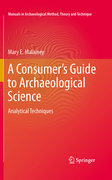
Many archaeologists, as primarily social scientists, do not have a backgroundin the natural sciences. This can pose a problem because they need to performchemical and physical analysis on samples to perform their research. This manual will be an essential source of information for those students without a background in archaeological science, but be a comprehensive overview that thosewith some science background will still find useful. The manual will provide readers with the knowledge to use archaeological science methods to the best advantage. It will describe and explain the analytical techniques in a manner that the average archaeologist can understand, and outline clearly the requirements, benefits, and limitations of each possible method of analysis, so that the researcher can make informed choices. The work includes specific information about the ways of analyzing most common types of archaeological samples, including: -pottery and ceramics-stone tools-bone and teeth-cultural rock-organicresidues-shell and plant remains-paints and pigments- metal-glass-sediments Since samples are often compromised or changed during experimentation, it is important to select the most effective technique for gaining the target information from the sample before proceeding. Readers will reach for this manual for whenever they need to decide how to best analyze a sample, and how to perform that analysis. -Specifically targetted at presenting scientific methods to archaeologists with no scientific background -Comprehensive guide for scientific techniques: how to perform them, which materials to use them on, and what results they will give -Useful both as a how-to manual, and a graduate level textbook INDICE: Part I: Basic Science.- Matter.- The Atom.- The Periodic Table of Elements.- Chemical Bonding.- Electromagnetic Radiation.- The Absorption of Energy by Atoms, Elements and Molecules.- Isotopes.- Radioactive Decay.- The Distribution of Isotopes in the Environment.- Organic Compounds.- DNA Replicationand the Polymerase Chain Reaction.- Acids and Bases.- Table of The Metric System and Conversions.- Table of Mathematical Symbols.- The Greek Alphabet.- Part II: Materials and Applications.-Pottery and other Ceramic Items.- Flaked andGroundstone Tools.- Bone and Teeth.- Cultural Rock.- Section 2.5 Organic Residues Relating to Food and Drink.- Organic Residues: Protein/Blood and DNA.- Other Organic Residues.- Organic Artifacts – Wood, Bone, Shell, Plant Remains.- Paints, Pigments and Ink.- Metal.- Glass.- Matrix and Environmental Deposits.-Other Materials.- Analytical Approaches and Instrumentation.- Dating Techniques Using the Decay of Radioactive Isotopes.- Radiocarbon Dating.- Potassium-Argon and Argon-Argon Dating.- Uranium Series/ Uranium-Thorium.- Fission tracks and Trapped Charge Dating Techniques.- Fission Track Dating.- Trapped Charge Dating: TL, OSL and ESR.- Obsidian Hydration.- Amino Acid Racemization.- Archaeomagnetism.- Atomic Absorption.- Chromatography.- Detectors.- Elemental Analysis.- Solid Sample Introduction Techniques.- Spectroscopic Techniques - IR, FT-IR, UV and Raman.- Nuclear Magnetic Resonance Spectroscopy.- Surface Characterization and Composition.- X-rays and Techniques that use X-rays to determined the composition of materials.
- ISBN: 978-1-4419-5703-0
- Editorial: Springer
- Encuadernacion: Cartoné
- Páginas: 350
- Fecha Publicación: 30/07/2010
- Nº Volúmenes: 1
- Idioma: Inglés
